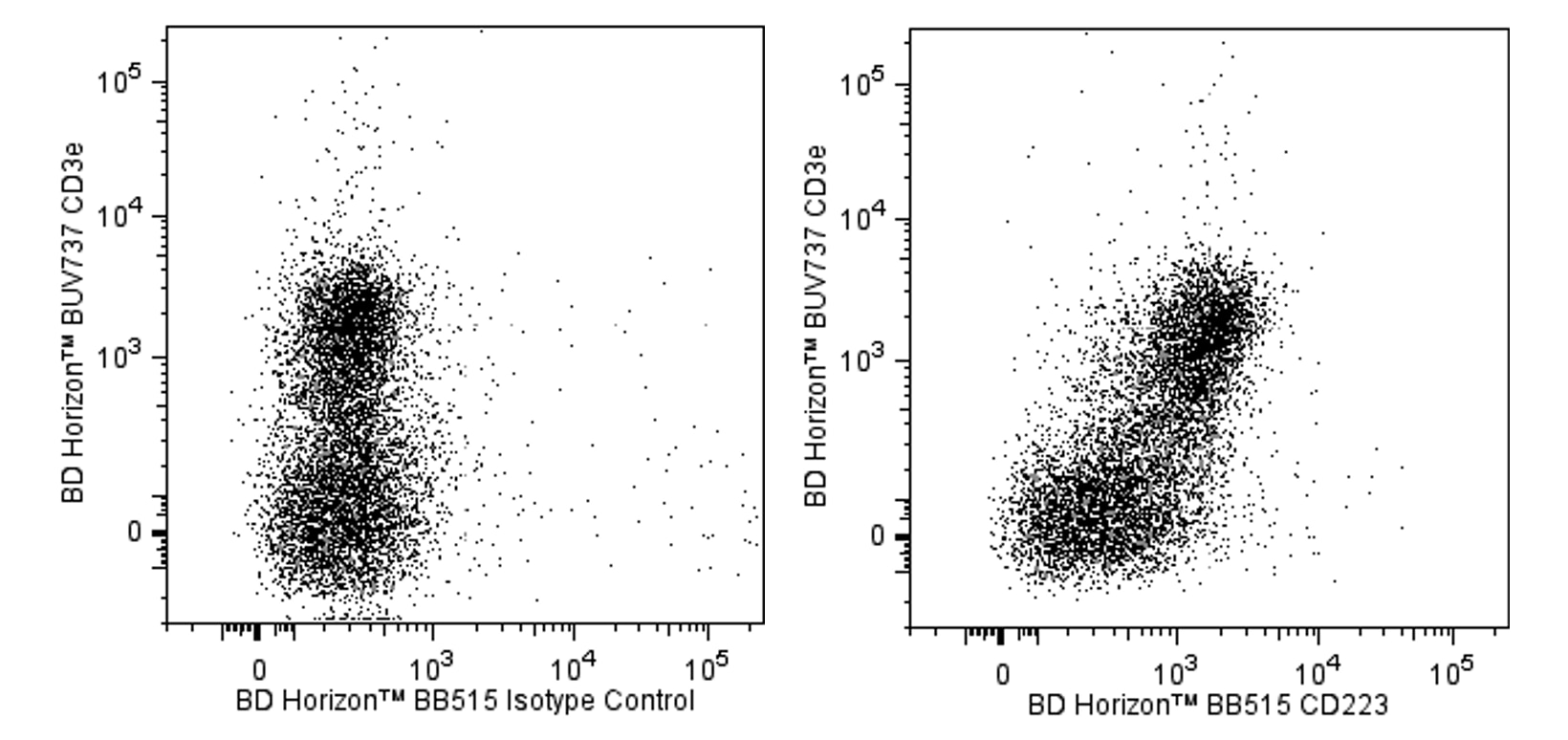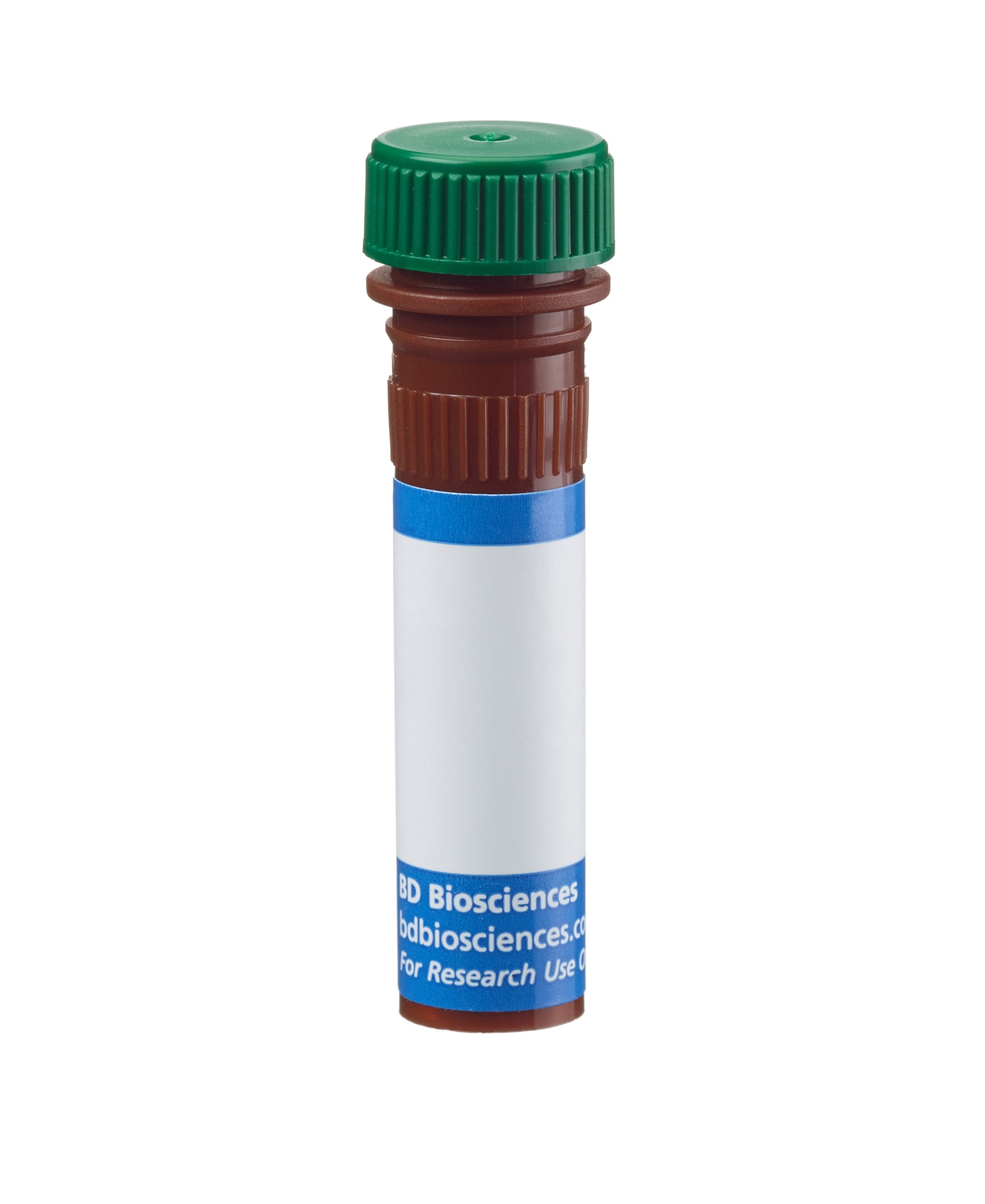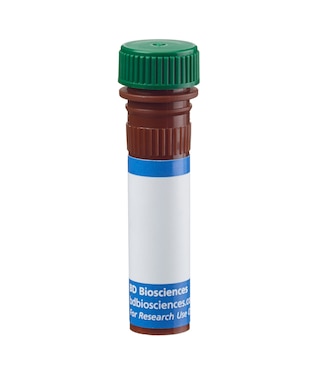Old Browser
Looks like you're visiting us from {countryName}.
Would you like to stay on the current country site or be switched to your country?




Two-color flow cytometric analysis of CD223 expression on activated mouse splenocytes. Mouse splenic leucocytes were stimulated in culture for 3 days with immobilized Purified NA/LE Hamster Anti-Mouse CD3e antibody (Cat. No. 553057). The cells were harvested, pre-incubated with Purified Rat Anti-Mouse CD16/CD32 antibody (Mouse BD Fc Block™) (Cat. No. 553141/553142) and then stained with BD Horizon™ BUV737 Rat Anti-Mouse CD3 Molecular Complex antibody (Cat. No. 564380) and either BD Horizon BB515™ Rat IgG1, κ Isotype Control (Cat. No. 564610; Left Panel) or BD Horizon BB515 Rat Anti-Mouse CD223 antibody (Cat. No. 564672; Right Panel). Two-color flow cytometric dot plots showing the correlated expression of CD223 (or Ig Isotype control staining) versus CD3 were derived from gated events with the forward and side light-scatter characteristics of viable activated splenocytes. Flow cytometric analysis was performed using a BD™ LSR II Flow Cytometer System.


BD Horizon™ BB515 Rat Anti-Mouse CD223

Regulatory Status Legend
Any use of products other than the permitted use without the express written authorization of Becton, Dickinson and Company is strictly prohibited.
Preparation And Storage
Recommended Assay Procedures
BD™ CompBeads can be used as surrogates to assess fluorescence spillover (Compensation). When fluorochrome conjugated antibodies are bound to CompBeads, they have spectral properties very similar to cells. However, for some fluorochromes there can be small differences in spectral emissions compared to cells, resulting in spillover values that differ when compared to biological controls. It is strongly recommended that when using a reagent for the first time, users compare the spillover on cells and CompBead to ensure that BD Comp beads are appropriate for your specific cellular application.
For optimal and reproducible results, BD Horizon Brilliant Stain Buffer should be used anytime two or more BD Horizon Brilliant dyes are used in the same experiment. Fluorescent dye interactions may cause staining artifacts which may affect data interpretation. The BD Horizon Brilliant Stain Buffer was designed to minimize these interactions. More information can be found in the Technical Data Sheet of the BD Horizon Brilliant Stain Buffer (Cat. No. 563794/566349) or the BD Horizon Brilliant Stain Buffer Plus (Cat. No. 566385).
For optimal results, it is recommended to perform 2 washes after staining with antibodies. Cells may be prepared, stained with antibodies and washed twice with wash buffer per established protocols for immunofluorescence staining, prior to acquisition on a flow cytometer. Performing fewer than the recommended wash steps may lead to increased spread of the negative population.
Product Notices
- Since applications vary, each investigator should titrate the reagent to obtain optimal results.
- An isotype control should be used at the same concentration as the antibody of interest.
- Caution: Sodium azide yields highly toxic hydrazoic acid under acidic conditions. Dilute azide compounds in running water before discarding to avoid accumulation of potentially explosive deposits in plumbing.
- For fluorochrome spectra and suitable instrument settings, please refer to our Multicolor Flow Cytometry web page at www.bdbiosciences.com/colors.
- BD Horizon Brilliant Stain Buffer is covered by one or more of the following US patents: 8,110,673; 8,158,444; 8,575,303; 8,354,239.
- Please refer to http://regdocs.bd.com to access safety data sheets (SDS).
- Please refer to www.bdbiosciences.com/us/s/resources for technical protocols.
Companion Products






The C9B7W antibody monoclonal antibody specifically binds to an epitope in the D2 domain of CD223 (LAG3), the 70-kDa protein encoded by Lymphocyte-activation gene 3 (Lag3). A fusion protein consisting of the entire extracellular region of mouse LAG3 with mouse IgG1 was used as immunogen. CD223 is a type-I membrane protein with four extracellular Ig-like domains; it is structurally homologous to CD4; and, like CD4, it binds MHC class II molecules. However, unlike CD4, it is not expressed on resting human and mouse T lymphocytes. In the mouse, as previously described in the human, CD223 expression is upregulated on T lymphocytes (both CD4+ and CD8+) activated through the T-cell receptor (TCR) and on IL-2-activated NK (LAK) cells, and it is not detected on B cells, dendritic cells, or Phorbol 12-myristate 13-acetate (PMA)-stimulated splenocytes. Studies on human peripheral T lymphocytes suggest that CD223 associates with the TCR to downregulate TCR signaling. In contrast, in vivo and in vitro evaluations of vaccination protocols in mice suggest that CD223 promotes immune responses by activating antigen-presenting cells. Furthermore, NK cells of Lag3-/- mice display defects in their capacity to kill certain tumor cells. Mouse CD223 also has been demonstrated to contribute to the suppressor function of T regulatory cells and the C9B7W antibody has been shown to inhibit this function in vitro and in vivo. Therefore, CD223 appears to play complex roles in the regulation of immune responses. Although the C9B7W antibody is unable to block the binding of MHC class II-IgG2a fusion protein to CD223, it is able to block the CD223-mediated inhibition of IL-2 production by a T-cell hybridoma responding to antigen.
The antibody was conjugated to BD Horizon BB515 which is part of the BD Horizon Brilliant™ Blue family of dyes. With an Ex Max near 490 nm and an Em Max near 515 nm, BD Horizon BB515 can be excited by the blue laser (488 nm) laser and detected with a 530/30 nm filter. This dye has been exclusively developed by BD Biosciences and is up to seven times brighter than FITC with less spillover into the PE channel. Due to similar excitation and emission properties, BB515, FITC, and Alexa Fluor® 488 cannot be used simultaneously. It is not recommended to use BB515 in cocktails that include Streptavidin conjugates as it may cause high background.

Development References (9)
-
Baixeras E, Huard B, Miossec C, et al. Characterization of the lymphocyte activation gene 3-encoded protein. A new ligand for human leukocyte antigen class II antigens. J Exp Med. 1992; 176(2):327-337. (Biology). View Reference
-
El Mir S, Triebel F. A soluble lymphocyte activation gene-3 molecule used as a vaccine adjuvant elicits greater humoral and cellular immune responses to both particulate and soluble antigens. J Immunol. 2000; 164(11):5583-5589. (Biology). View Reference
-
Hannier S, Tournier M, Bismuth G, Triebel F. CD3/TCR complex-associated lymphocyte activation gene-3 molecules inhibit CD3/TCR signaling. J Immunol. 1998; 161(8):4058-4065. (Biology). View Reference
-
Hannier S, Triebel F. The MHC class II ligand lymphocyte activation gene-3 is co-distributed with CD8 and CD3-TCR molecules after their engagement by mAb or peptide-MHC class I complexes. Int Immunol. 1999; 11(11):1745-1752. (Biology). View Reference
-
Huang CT, Workman CJ, Flies D, et al. Role of LAG-3 in regulatory T cells. Immunity. 2004; 21(4):503-513. (Clone-specific: Flow cytometry, Functional assay, Inhibition, In vivo exacerbation). View Reference
-
Huard B, Mastrangeli R, Prigent P, et al. Characterization of the major histocompatibility complex class II binding site on LAG-3 protein. Proc Natl Acad Sci U S A. 1997; 94(11):5744-5749. (Biology). View Reference
-
Miyazaki T, Dierich A, Benoist C, Mathis D. Independent modes of natural killing distinguished in mice lacking Lag3. Science. 1996; 272(5260):405-408. (Biology). View Reference
-
Prigent P, El Mir S, Dréano M, Triebel F. Lymphocyte activation gene-3 induces tumor regression and antitumor immune responses. Eur J Immunol. 1999; 29(12):3867-3876. (Biology). View Reference
-
Workman CJ, Rice DS, Dugger KJ, Kurschner C, Vignali DA. Phenotypic analysis of the murine CD4-related glycoprotein, CD223 (LAG-3). Eur J Immunol. 2002; 32(8):2255-2263. (Immunogen: Flow cytometry, Functional assay, Inhibition). View Reference
Please refer to Support Documents for Quality Certificates
Global - Refer to manufacturer's instructions for use and related User Manuals and Technical data sheets before using this products as described
Comparisons, where applicable, are made against older BD Technology, manual methods or are general performance claims. Comparisons are not made against non-BD technologies, unless otherwise noted.
For Research Use Only. Not for use in diagnostic or therapeutic procedures.
Report a Site Issue
This form is intended to help us improve our website experience. For other support, please visit our Contact Us page.